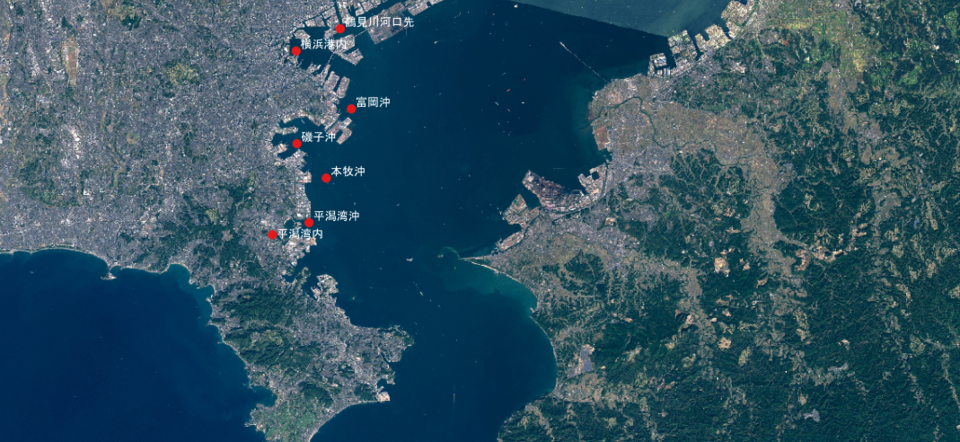Here's the text.
Tokyo Bay Substance Survey
Last Updated August 8, 2024
What is the Tokyo Bay Survey?
Investigate the status of dissolved oxygen, dredging, and benthic organisms of the bottom water in Tokyo Bay with the aim of understanding the actual conditions of the bottom water environment in Tokyo Bay and confirming the trend of improvement of bottom sediment through measures to improve bottom sediment. Implement.
The results of these surveys conducted by Chiba Prefecture, Tokyo, Kanagawa Prefecture, Yokohama City and Kawasaki City in a unified manner are compiled into one report by the Water Quality Improvement Subcommittee of the Nine Prefectural City Summit Environmental Issues Countermeasures Committee. You.
Yokohama City conducts a survey of the city's shared water areas (7 sea areas) stipulated in the "Kanagawa Prefecture Public Water Area and Groundwater Quality Measurement Plan" in two years (annual offshore Honmoku every year) ).

Source: Geographical Survey Institute website (https://maps.gsi.go.jp/development/ichiran.html)
Method of Evaluation
We will evaluate the sediment environment of Tokyo Bay based on the "Second Quality Assessment Method for Benthic Organisms in Tokyo Bay" formulated in 1999.
| ① | Total number of benthic organisms | More than 30 species | 20 to 30 species | 10 to 19 species | Less than 10 species | Inanimate |
Score | 4 | 3 | 2 | 1 | 0 | |
| ② | Percentage of crustaceans to total present (%) ≪*1≫ | 20% or more | Less than 10% to 20% | Less than 5 to 10% | Less than 5% | 0% |
| Score | 4 | 3 | 2 | 1 | 0 | |
| ③ | High heat reduction of bottom quality (%) | Less than 2 | Less than 5 | Less than 10 | Less than 15 | 15 or more |
| Baseline COD (mg/g) ≪*2≫ | Less than 3 | Less than 15 | Less than 30 | Less than 50 | 50 or more | |
| Score | 4 | 3 | 2 | 1 | 0 | |
| ④ | Euphorus indicator organism | A | B | C | D | |
| Creatures other than B and C | Lumbrineris longifolia | Paraprionospio sp. (Spio family) | Inanimate | |||
Raeta rostralis | Theora fragilis | |||||
Prionospio pulchra | Sigambra sp. | |||||
| Evaluation based on the top three dominant species ≪*3≫ | The top three species are all A creatures (rank A) | Those that are not classified into ranks A, C, or D (rank B) | 2 or more species of C (rank C) | (Level D) | ||
| Score | 3 | 2 | 1 | 0 | ||
*1 If the total number of appearances is 4 or less, the score is 1 even if the ratio of crustaceans is large.
*2 As for the evaluation of bottom organic matter, a high heat reduction is used in principle, but if this is not measured, it is evaluated with bottom-line COD.
*3 Evaluations based on Euphorbia are performed in the following order.
①In the case of inanimates, it is rank D.
②If the total number of appearance types is 2 or less, it shall be ranked C.
③If there are two or more indicator organisms in Group C, it is ranked C.
④If all three types are other than the B and C groups, they are ranked A.
⑤If it is not classified as A, C, or D rank, it is rank B.
| Environmental evaluation category | Score (total) | Description |
|---|---|---|
| Environmental Conservation Level IV | 14 or more | The environment is well preserved. It is inhabited by a variety of benthic organisms, sediment is sandy and aerobic. |
| Environmental Conservation Level III | 10~13 | The environment is generally well preserved, but the habitat may temporarily deteriorate due to a decrease in dissolved oxygen in low-rise water during the summer months. |
| Environmental Conservation Level II | 6~9 | Organic pollution of the sediment is progressing and may become an oxygen water area. Benthic organisms are dominated by species that withstand pollution. |
| Environmental Conservation Level I | 3~5 | It temporarily becomes an oxygen-free zone, and most of the bottom is black sludge-like. Benthic organisms are mainly species that can withstand pollution, and both the number of species and population are small. |
| Environmental conservation degree 0 | 0~2 | There is little dissolved oxygen, and no living organisms live. The bottom is black and sludge-like. |
For details on the evaluation method, please refer to No. 2, 2000 National Pollution Research Magazine, “Guidelines for Benthic Survey in Tokyo Bay and Methods for Benthic Organisms” (PDF: 884KB).
Results of the survey
The survey results are published in the Tokyo Bay Substance Survey (outside site) of the Nine Prefectural City Summit Environmental Issues Countermeasures Committee Water Quality Improvement Subcommittee.
You may need a separate PDF reader to open a PDF file.
If you do not have it, you can download it free of charge from Adobe.
![]() To download Adobe Acrobat Reader DC
To download Adobe Acrobat Reader DC
Inquiries to this page
Water and Soil Environment Division, Environmental Conservation Department, Green Environment Bureau
Telephone: 045-671-2494
Telephone: 045-671-2494
Fax: 045-671-2809
Email address: mk-mizudojo@city.yokohama.lg.jp
Page ID: 448-340-550







